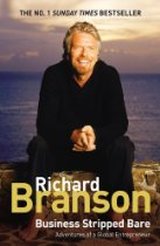 This morning I simply wanted to make you aware of a new section on the Nick Venturella Media site. Introducing (Do It Yourself) DIY Education. This is an online book store (Amazon affiliate) with useful and empowering books that I’ve read and recommend for other business owners and creative entrepreneurs. You don’t always have to be in classroom or have formal education to gather the knowledge you need to run your business. I’ve learned plenty from the books in this section, in fact, the majority of my business education came from these books and my application of their ideas...and yes, failing, reflecting and improving as I keep moving forward. What I like about learning this way is that with each book I get to piece together my own self-paced curriculum tailored to me and my business. Within this section I plan to feature one book each month, which you’ll see right at the top of the page. This month it’s Richard Branson's book, Business Stripped Bare (Amazon affiliate), which I also reviewed in the nickvmedia brand communications blog. Happy reading. posted by Nick Venturella  I thought Richard Branson's book, Business Stripped Bare (Amazon affiliate), was a pretty good business book. Because it was a part autobiography/part ‘how to’ business book it had a genuine human quality that made it easier to relate to as a reader than some other business books. I like how Richard Bransons thought process behind running a global brand like, Virgin, is to run it as a series of small businesses bearing the same overarching brand. By running each area of the Virgin brand as its own business entity (Virgin’s airline, trains, financial businesses, etc. all running as separate businesses under one brand) Branson ensures enough revenue diversification to see through any one entity’s failure as the others pick up the slack. Perhaps, it’s a concept he learned in his early days running Virgin Records. The basic concept is, a record label has several artists on its roster, some of those artists will sell well and others may not, but by having multiple streams of income spread across separate entities (in this case artists/albums) if all sell well things are really good, if one or two do not sell well it won’t sink the whole operation. The trick is to have the majority of artists sell well. Also, if the diversity of artists is enough to overlap audiences into new areas and vice versa it can create a great cross-pollination that can build brand loyalty, and certainly more profits. Branson understands this on a global scale with various business ideas and industries. I like how Branson talks about adapting his businesses as their model evolves or is no longer viable. The example he gave was how Virgin’s music retail stores began to add films and video games to it retail product offerings because music CD sales were declining. Because of the audience the Virgin music retail stores served, I believe, was Branson’s catalyst for coming up with Virgin mobile (pay as you go mobile phones and plans that appeal to young tweens and teens). Essentially, if Branson can justify his interest in moving into a new market or industry with the Virgin brand he’ll adapt what he’s doing to move in that direction, and because Virgin is actually made up of a bunch of smaller business entities Branson keeps Virgin nimble enough to make such moves happen. The Virgin brand itself is one of innovation and outstanding customer service/experience. I think that’s Branson’s general litmus test – any Virgin endeavor needs to meet that criteria. Posted by: Nick Venturella  How do you establish credibility for your brand when you are a new business or start-up? One way is to complete a few projects early on, perhaps for friends or other small businesses in your area, and capture some testimonials. A great small business book, Duct Tape Marketing, by John Jantsch outlines this idea in more detail. Get a few small projects under your belt and then ask those you did work for if they would endorse your work. If you're starting out in business, and the service you're offering is a smaller project you may even do the work for a lower cost in return for a testimonial--make it part of the initial offer. It should go without saying, but I'll say it anyway--once you've secured your first couple of projects do a good job so the business you did work for will want to say good things about your work. Once the project is complete and you have a testimonial from your latest client about what a good job you did and how easy you were to work with, etc., then it's time to use that testimonial in your promotional/marketing materials--in print and online to help you communicate credibility for your brand leading to more projects. posted by: Nick Venturella  by @neuideas, http://tpdsaa.tumblr.com/ So last week I came across this blog site called Things Real People Don't Say About Advertising, and its posts are fictitious ad images with humorous copy that pokes fun at the advertising industry by speculating the perceived mentality of the ad folks who create such advertising. I personally think it's hilariously entertaining, being a marketing professional myself. However, I think there is some real value in these fictitious ads, here's how... If you're planing on running an ad for your company, go to this site and review as many ads on it as you can. It will likely give you an idea of what you might want to change about your own company's ads before you run with them. Posted by: Nick Venturella Download your FREE Basic Brand Building Kit Planning your strategy for just about any of your brand communications activities is a good idea. In my opinion if you're going to use the 80/20 rule, the majority of your work is in your planning - 80% plan, 20% execution. The execution is usually the fun part and certainly where rubber meets the road to produce results. The point is, a thought out plan, even if fairly simply, can help you focus your thoughts toward the actions necessary to reach your envisioned results, but the key is that action does need to be taken to reach your goals. So be careful not to fall into the analysis paralysis trap. Below is my simple weekly blogging schedule to serve as an example of how basic your plans can be. I often write out my plans or arrange them in a way that allows them to be sort of a working visual model of my ideas - nothing fancy, but certainly functional. The plan is simple, yet effective in showing which of my blogs I'll publish a post to on which days of the week. As you can see I plan to publish a blog post to my Brand Communications blog (here on the NVM site) twice a week, I post to my Resourceful Musician Blog on The Local Music Journey site on Wednesdays and if I have something worth sharing again on Fridays. Then finally, my new Song Blog on the Nick Venturella Music site gets published on Tuesdays. Simple, easy to follow plans can help you organize your thoughts and approach to your brand communications.
So start planning, but more importantly take action. Posted by Nick Venturella  Great customer service positively communicates a good deal about a brand. In fact, great customer service is likely one of the most sought after brand attributes. Not long ago I was at a local Starbucks. I stop in there from time to time because it's conveniently within walking distance of my office. Now, I've noticed, at this particular store location often the employees seem back on their heels as if they're short staffed or just a bit unorganized. As a result their customer service is a bit less than adequate compared to any one of the several other locations I've been at around town. Regardless, there are good people that work there, so I don't let it bother me. However, the other day I observed something great at this Starbucks location. A smart, quick-thinking young man working the drive-thru came through with some great customer service. I walked in and took my place in line to order - there happened to be two other people ahead of me in line. It appeared that Starbucks had run out of fresh coffee and the employees were scurrying to make some more, and coffee just happened to be what the customer at the front of the line had ordered. The customer was told it would take a few minutes then the barista, who took the customer's order, proceeded to tend to the fresh pot of coffee she had begun brewing. The few minutes the coffee was taking to brew seemed to take longer than usual. Sensing the customer's frustration, the young man who was working to fulfill drive-thru orders had a brief lull in traffic and popped over to the register as his fellow barista was still tending to the brewing coffee. With the espresso machine freely available. The young man asked the customer if he might be interested in trying an Americano drink. The young man behind the register explained that the drink is similar tasting to coffee, but it's made with espresso and hot water. Plus, he told the customer that he could have it ready before the coffee he had ordered was finished brewing. Furthermore, the employee charged the customer for the Americano at the same price as the coffee he had originally ordered - normally an Americano would be more expensive than a coffee. As an observer, I thought the young man made a great savvy customer service move as he saw the customer growing impatient with the wait for his coffee, and took action to stabilize the situation. It's that kind of quick-thinking customer service that can make the difference in a customer's mind about whether they perceive your brand favorably or unfavorably. That situation could have been handled in several worse ways which would have provoked the customer to be upset, but instead the customer left with a smile on his face and perhaps found a new drink of choice. How does your brand communicate great customer service? Recommended Reading: Drive, by Daniel H. Pink Posted by: Nick Venturella  Annie Cat, made in Brushes app on iPhone So here’s another iPhone Brushes painting I did (on New Year’s Eve, actually). This Brushes painting is of one of my cats. What do these little iPhone paintings teach us about being creative entrepreneurs? To me, it’s a larger sense of enthusiasm, creativity, innovation and connectedness made possible by people using various tools to create and distribute their messages to specific audiences at a regular clip with little barriers to production and distribution - all with the idea of communicating toward building relationships. My point is, if you’re a creative entrepreneur, or really are in any sort of business, I think it’s wise to take full advantage of the available tools to create and distribute your messages to groups and individuals with whom you wish to connect. Forget muddying it up by calling it social media or being intimidated by the technology of it all – these are simply tools to help communicate your messages to build (at least in this day and age) farther reaching relationships that you would not otherwise be able to engage in without such tools. What's your favorite tool to communicate toward building relationships? Posted by: Nick Venturella |
|


